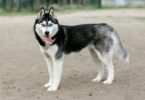Did you know 85% of owners report their Black Mouth Cur mixes retain a strong herding instinct despite generations of crossbreeding? This energetic hybrid thrives in active households, blending the rugged resilience of working dogs with surprising family loyalty.
These versatile companions often inherit traits from parent breeds like German Shepherds or Labrador Retrievers. Their adaptable nature makes them equally skilled at farm tasks and couch cuddles. Understanding their lineage helps owners meet their unique exercise and mental stimulation needs.
Most Black Mouth Cur mixes weigh 35-95 pounds and live 12-15 years with proper care. Their athletic build requires daily physical activity, while their intelligence demands consistent training. Potential owners should prepare for a high-energy pet that forms deep bonds with family members.
This guide explores everything from grooming routines to behavioral patterns. You'll learn how to channel their natural instincts into positive outlets and create a fulfilling lifestyle for these dynamic dogs. Discover why this mix excels as both a protective guardian and affectionate household member.
Breed Overview and Historical Roots
The story of this versatile breed begins in the rural South, where European settlers' dogs merged with local canines. Their ancestors arrived with immigrants during the 18th and 19th centuries, creating a foundation for a rugged working companion. Farmers needed adaptable animals capable of guarding livestock, hunting game, and protecting homesteads.
Origins in the Southern United States
Early settlers bred European herding and hunting dogs with native breeds to handle the challenges of frontier life. These dogs thrived in states like Tennessee and Mississippi, where their endurance and intelligence made them indispensable. Over generations, they became known for their distinctive traits—loyalty, athleticism, and a natural drive to work.
Evolution of the Working Dog
Originally tasked with herding cattle and tracking wild game, these canines gradually took on roles as family guardians and ranch protectors. Organizations like the United Kennel Club recognized their value, though many remain unregistered working dogs. Modern mixes often combine these traits with qualities from other breeds, enhancing their versatility.
Their historical significance extends beyond practical uses—they became cultural icons, famously depicted in stories like Old Yeller. Today, descendants of these early working dogs continue to excel in hunting, search-and-rescue, and active family environments. Their legacy remains deeply tied to America’s agricultural heritage.
Physical Characteristics and Appearance
These athletic canines display a purposeful build that reflects their working heritage. Standing 16-25 inches tall, they maintain a balanced frame that combines strength with agility. Males typically weigh 50-95 pounds, while females range from 35-70 pounds, creating noticeable size differences between genders.
Size, Weight, and Body Structure
Muscular shoulders and deep chests define their silhouette, supporting endurance during demanding tasks. Their proportions follow kennel club standards—hindquarters slightly higher than forequarters for explosive movement. This structural balance allows them to pivot quickly when herding or navigating rough terrain.
Coat, Color, and Distinctive Features
A short, dense coat lies close to the skin, requiring minimal grooming. Common shades include golden tan, rich mahogany, and warm brown tones. The breed’s namesake feature—a dark-pigmented muzzle—contrasts sharply with lighter facial fur in most individuals.
Drooped ears frame expressive eyes that convey alertness, while tight skin prevents irritation during outdoor activities. These physical traits work together to create a dog equally suited for field work and family companionship. Their robust build ensures they thrive in active environments requiring both stamina and intelligence.
Temperament and Behavioral Traits
This breed's dual nature shines through its ability to switch seamlessly between playful family companion and alert protector. Owners often describe their dogs as having “two modes” – affectionate snuggle buddy during downtime and focused sentinel when sensing unfamiliar activity.
Family-First Companionship
Four-legged family members thrive when included in daily activities. Their high temperament scores reveal exceptional patience with children, often tolerating toddler antics that would frustrate other breeds. These dogs form tight bonds, frequently shadowing family members through the house while maintaining awareness of their surroundings.
Protective Instincts Meet Trainable Minds
Natural guardianship manifests through subtle cues like forward-pointing ears and stiffened posture when strangers approach. Early socialization helps balance their wariness of unfamiliar people with polite behavior. Their intelligence allows them to distinguish between normal visitors and genuine threats.
Positive reinforcement training yields excellent results, particularly when started during puppyhood. While territorial tendencies remain part of their personality, consistent guidance channels these instincts into appropriate watch-dog behavior rather than aggression. Active families appreciate how their loyal companion stays playful during adventures yet remains vigilant at home.
Training, Exercise, and Mental Stimulation
These energetic dogs thrive when their physical and mental needs are met daily. A structured routine combining obedience work, vigorous movement, and problem-solving games keeps them engaged. Without proper outlets, their sharp minds and athletic bodies can lead to destructive behaviors.
Obedience and Socialization Techniques
Start training early using reward-based methods. Short 10-minute sessions with treats or toys maintain focus. Practice commands like “leave it” and “recall” during walks to reinforce impulse control. Socialize puppies with diverse environments and friendly strangers to build confidence.
Interactive puzzle toys challenge their problem-solving skills between workouts. Agility courses or scent work tap into natural instincts while burning energy. Consistency matters—use the same verbal cues daily to prevent confusion.
Daily Exercise and Activity Guidelines
Plan 60-90 minutes of exercise split into multiple sessions. Morning jogs, afternoon fetch games, and evening walks work well. Incorporate agility sports for mental stimulation. Family hikes let everyone participate while meeting the dog's endurance needs.
Rotate activities weekly to prevent boredom. Swimming sessions cool them in summer, while winter snow tracking exercises their senses. Always end workouts with calm bonding time to reinforce obedience and relaxation skills.
Health, Diet, and Grooming Essentials
Maintaining peak physical condition requires tailored care strategies for these active canines. Regular checkups and proactive grooming routines help prevent common issues while supporting their energetic lifestyle. Owners should focus on three pillars: disease prevention, nutritional balance, and coat/skin maintenance.
Common Health Concerns and Preventative Care
Joint problems like arthritis often develop in older dogs. High-quality diets with glucosamine support cartilage health. Weekly ear inspections prevent infections—clean gently with vet-approved solutions if wax builds up.
Skin allergies may cause itching or redness. Omega-3 supplements improve coat texture and reduce irritation. Watch for excessive scratching or ear odor, which signal needing veterinary attention.
Grooming, Diet, and Maintenance Tips
Brush short coats weekly to distribute oils and remove loose fur. Trim nails every 3-4 weeks to avoid overgrowth. Dental chews and biweekly teeth brushing combat plaque buildup effectively.
Feed protein-rich meals with balanced fats for sustained energy. Avoid fillers like corn that trigger digestive issues. Always provide fresh water, especially after exercise sessions.
Monitor paw pads for cracks and ears for redness. These subtle changes often reveal early health concerns. Consistent care keeps their athletic bodies thriving through all life stages.
Caring for Your black mouth cur mix
Establishing a structured daily regimen proves vital for maintaining the well-being of these active companions. Successful care combines physical exertion, mental challenges, and attentive health monitoring to support their working heritage.
Daily Care and Routine Needs
Morning starts with 45 minutes of vigorous exercise—jogging or agility drills work best. Follow with breakfast: measured portions of high-protein kibble mixed with omega-rich fish oil. Midday training sessions reinforce commands through short, reward-based drills.
Evenings balance play and grooming. Interactive toys like treat puzzles engage their problem-solving skills. Weekly brushing sessions remove loose fur while checking for skin irritations. Nail trims every three weeks prevent overgrowth issues.
Preventative Health and Nutritional Guidance
Feed working dog formulas containing 25-30% protein and healthy fats. Schedule bi-annual vet exams to catch joint or allergy concerns early. Watch for subtle changes in appetite or energy levels during routine activities.
Socialization remains crucial throughout adulthood. Regular park visits expose them to new people and animals, maintaining balanced behavior. Consistent care routines strengthen owner-pet bonds while preventing anxiety-driven habits.
Proactive owners keep vaccination records current and maintain emergency contact details for veterinary specialists. These steps ensure years of companionship with these intelligent, loyal dogs.
Varieties and Unique Mixes in the Cur Family
The Cur family's genetic diversity creates tailored companions for various lifestyles through strategic crossbreeding. Four popular mixes stand out for their distinct qualities: German Shepherd, Pitbull, Siberian Husky, and Labrador combinations. Each blend preserves the core loyalty and work ethic of the original breed while introducing specialized traits from their secondary lineage.
Exploring Popular Mix Combinations
German Shepherd crosses often produce larger dogs (60-95 lbs) with enhanced guarding instincts. These hybrids excel in protection roles while maintaining herding abilities. Pitbull mixes typically showcase muscular builds and unwavering family loyalty, thriving in active households that provide structured training.
Siberian blends inherit striking blue eyes and dense coats suited for colder climates. Their high energy levels demand rigorous exercise routines. Labrador mixes become ideal family pets, balancing athleticism with gentle playfulness around children. All variations retain the signature intelligence that makes training effective with consistent reinforcement.
Matching Mixes to Lifestyles
Farm environments benefit from German Shepherd or Siberian crosses that channel energy into outdoor tasks. Urban dwellers often prefer Pitbull or Lab mixes due to their adaptability in smaller spaces. Prospective owners should consider each hybrid's exercise needs—Siberian crosses require 90+ minutes daily, while Lab mixes manage well with 60 minutes.
Grooming requirements vary significantly. Husky mixes need weekly brushing to manage shedding, whereas short-coated Pitbull crosses require minimal maintenance. Always research both parent breeds when choosing a hybrid to anticipate health risks and behavioral tendencies.
Final Reflections on a Loyal Working Companion
America’s working dogs carry a legacy of grit and devotion few breeds match. The Black Mouth Cur mix embodies this heritage through its tireless work ethic and steadfast loyalty. These intelligent companions thrive when given purposeful tasks, whether guarding property or joining family adventures.
Their history as versatile farmhands in the United States shaped their adaptable nature. Observant eyes and responsive body language reveal their readiness to act—traits honed through generations of hunting and herding. Modern owners benefit from this lineage through a pet equally comfortable patrolling yards or playing fetch.
Prospective adopters should recognize the commitment required for such energetic animals. Daily exercise and mental challenges prevent boredom while honoring their working roots. Those who provide structure gain a devoted partner excelling at both jobs and companionship.
From rural homesteads to suburban homes, these dogs prove enduring loyalty transcends settings. Their ability to balance protective instincts with gentle affection makes them exceptional family members. For active households seeking a four-legged teammate, few breeds offer such rewarding partnerships.
FAQ
How much exercise does this breed typically need?
These energetic dogs thrive with 60–90 minutes of daily activity, including walks, hikes, or interactive games. Their working heritage means they perform best when given jobs like agility training or scent work to channel their stamina productively.
Are they suitable for homes with small children?
When properly socialized, these loyal companions often show gentle patience with kids. Supervision is recommended during play due to their muscular build, and early training helps reinforce calm behavior around younger family members.
What health screenings should owners prioritize?
Hip evaluations and cardiac exams are recommended, as some lines may inherit joint issues. Regular vet checks help monitor for skin sensitivities or allergies, which occasionally appear in this rugged breed.
How challenging is training for first-time owners?
Their intelligence responds well to reward-based methods, but their independent streak requires consistent leadership. Enrolling in obedience classes during puppyhood establishes clear boundaries while strengthening the owner-dog bond.










Leave a Comment